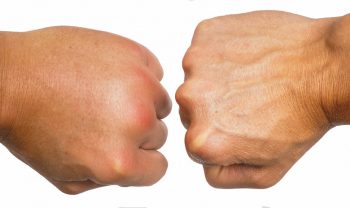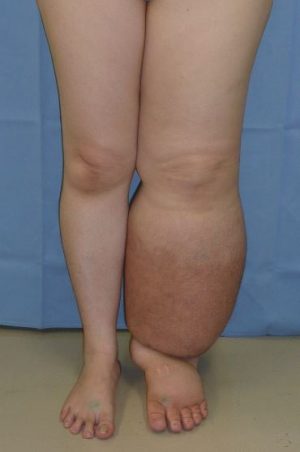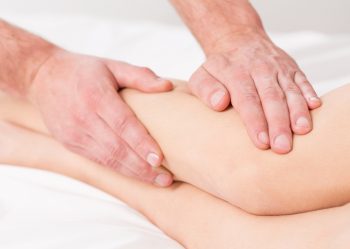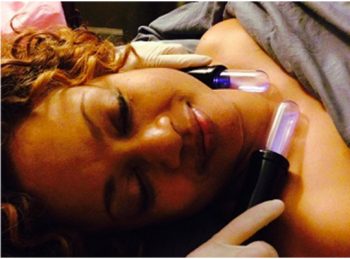What is the Difference Between
Edema and Lymphedema?
What is Edema?
Edema is the formal scientific word that simply means “swelling.”
Regular edema is what happens when there has been an injury to the body. In an attempt to splint or stabilize the area so that further movement can’t cause more harm, the circulatory system (heart/blood) rushes fluid to the affected area. This results in inflammation and edema (swelling).

These fluids contain small amounts of protein and are nutrient rich. These nutrients help to repair the damaged tissue.
Under normal circumstances, the edema goes down over a period of time as the healing progresses. The tissues then return to their normal size and appearance. There are generally no permanent tissue changes that come as a direct result of the swelling.
What is Lymphedema?
Lymphedema is a disease that is caused by chronic, or persistent, swelling that does not resolve. Over a long period of time this persistent swelling that results in permanent tissue changes to that area of the body.
As mentioned earlier, the fluid that causes all swelling contains protein. In contrast to regular edema where the fluid contains small amounts of protein, the fluid in Lymphedema contains high amounts of protein.
When this protein-rich lymphatic fluid is not removed as it should be by the lymphatic system, the amount of protein in the area continues to build up.

Lymphedema that has not been treated.
Because protein molecules are charged, meaning they have a positive and negative pole like a magnet, they tend to bind together when they are near one another. Protein molecules attract water. The high concentration of protein in the fluid in the space surrounding the cells (swelling) then attracts even more fluid to come out of the bloodstream.
In contrast to regular temporary edema, Lymphedema is characterized by inflammation. This inflammation is the body’s response to the long-standing fluid and protein buildup.
The inflammatory response brings specialized cells to the area. These cells are called fibroblasts. The job of fibroblasts is to produce collagen, the most commonly found protein in the human body. In healthy tissue, collagen acts like a scaffold to give structure to soft tissues.
When collagen is present in excessive amounts this results in tissue changes like fibrosis, sclerosis, and induration – three words that mean the hardening of the affected tissues. As the disease of Lymphedema progresses, the lymphatic system becomes more impaired and this triggers the body to begin to lay down layers of adipose tissue (fat) in addition to the fibrotic (hard) tissue. This tissue is called “fibro-fatty” tissue.
What is important to remember is that if you are diligent with your Manual Lymphatic Drainage (MLD) and your compression, the fluid, protein, and fibroblasts that are responsible for tissue changes are removed.
If caught in the early stages Manual Lymphatic Drainage and/or Complete Decongestive Therapy along with compliance regarding wearing compression garments, Lymphedema can be controlled and does not result in significant changes to the body’s appearance.
If tissue changes have already occurred, it is often possible to improve significantly the condition of the tissue through Complete Decongestive Therapy. While the size of the affected area may not reduce significantly, there is generally a tremendous amount of improvement in the sensation, health, and appearance of the affected area.
The Difference Between Edema and Lymphedema
In short, Edema is a temporary condition that will go away in time, usually with no special treatment or intervention. The fluid contains small amounts of protein and will not cause permanent tissue changes if it follows the normal pattern of swelling and inflammation followed by the
Lymphedema is a progressive swelling condition that is protein rich. The protein attracts more fluid and without intervention to keep the swelling at bay, it will get worse instead of better over time. If not addressed early, the tissue changes can become permanent.
Without management of lymphedema serious health complications can result.
What Are the Two Main Types of Lymphedema?
Primary Lymphedema
Primary Lymphedema is something that people get because they have genes which cause the lymphatic system to be abnormal in some way.
In essence, some of us are born with lymphatic super highways, and some of us are born with dirt roads for a lymphatic system. In actual fact, people with primary lymphedema may have an absence of lymphatic vessels, an overabundance of lymphatic vessels that are contorted and disfigured, and/or an absence of lymph nodes.
Due to this abnormality lymph does not move properly in the body and stagnates in one or more areas. This long-term stagnation of lymph results in the tissue changes characteristic of lymphedema including swelling, formation of fibrotic (hard) tissue, and fat deposition.
Interestingly, people can have Primary Lymphedema and not know it for some time. Primary Lymphedema is often triggered when a trauma of some sort happens to the affected limb. This trauma can be as simple as a scratch that gets infected or a bee sting. When the body rushes fluid to the area as part of the natural inflammatory response, it can’t get out and the first signs of Primary Lymphedema become apparent. From this point, the disease is irreversible (but can be managed).
There are several genetic syndromes that cause Primary Lymphedema, including Klippel-Trenaunay Syndrome, Turner Syndrome, Noonan Syndrome, Distichiasis, Prader-Willi Syndrome, and Parks Weber Syndrome. Due to the fact that lymphedema is grossly under-diagnosed, it is not known how many people actually suffer from primary lymphedema.
Secondary Lymphedema
Secondary Lymphedema is the most common type of Lymphedema in the US. As opposed to Primary Lymphedema where the cause is based on genetic factors, Secondary Lymphedema is acquired from factors outside of the body. These causes can include surgery, radiation, cancer, Chronic Venous Insufficiency (CVI), trauma, obesity, and filariasis (caused by roundworms).
According to the National Institutes of Health, Breast Cancer-Related Lymphedema (BCRL), a type of secondary lymphedema, occurs in 40% of breast cancer patients.
Treatment Options
Edema and Lymphedema can both benefit from lymphatic drainage. Two different styles of lymphatic drainage are available at Pain & Swelling Solutions: Manual Lymphatic Drainage (MLD) and Electro-Lymphatic Therapy.

With Edema, lymphatic drainage is usually enough to reduce the swelling. Although it isn’t absolutely necessary, it is extremely helpful in quickly reducing swelling and pain and speeding healing.

With Edema, lymphatic drainage is usually enough to reduce the swelling. Although it isn’t absolutely necessary, it is extremely helpful in quickly reducing swelling and pain and speeding healing.
In the case of Lymphedema that has gone untreated, Complete Decongestive Therapy (CDT) is necessary to begin by bring down the swelling and fibrosis through lymphatic drainage techniques and compression bandaging.
Once the CDT therapy is complete, swelling reduction is maintained by wearing specially-designed garments that keep the area very well compressed.
At Pain & Swelling Solutions we offer all of these therapy options. Make your appointment with Pain & Swelling Solutions today by clicking on the link below to feel better soon!



